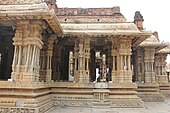Vijayanagara architecture
[3] Large multi-purpose halls (mandapas) surrounding the main shrine with elaborate and intricately carved pillars and the tall entrance towers (Gopurams, more specifically Rayagopurams named after the ruling Rayas) are two notable Vijayanagara additions to South Indian temple architectural tradition.For the approximately 400 years during the rule of the Western Chalukya and the Hoysalas empires, the most popular material for temple construction was chloritic schist or soapstone.During the Vijayanagar period the local hard granite was preferred in the Badami Chalukya style, although soapstone was used for a few reliefs and sculptures.Because granite is prone to flaking, few pieces of individual sculptures reached the high levels of quality seen in previous centuries.To cover the unevenness of the stone used in sculptures, artists employed plaster to give the rough surface a smooth finish and then painted it with lively colours.This Tamil dravida-influenced style became popular during the rule of king Krishnadevaraya and is seen in South Indian temples constructed over the next 200 years.[9] The Mandapas are built on square or polygonal plinths with carved friezes that are four to five feet high and have ornate stepped entrances on all four sides with miniature elephants or with Yali balustrades (parapets).Pillars, beams and rafters inside the palace were made of wood as evidenced by ash discovered in excavations.Palaces commonly consisted of multiple levels with each flight of stairs decorated by balustrades on either side, with either yali (imaginary beast) or elephant sculptures.[2] The impact of this style of architecture was seen well into the 17th century when the successive Nayaka kingdoms continued to encourage pillars with hippogryphs and granite became the main building material.










ShikharaVijayanagara EmpireSouth IndiaVijayanagaraTungabhadra RiverKarnatakaVijayanagara districtUNESCOWorld Heritage SiteWestern ChalukyaGovernment of KarnatakaChalukyaHoysalaRashtrakutaPandyaHoysalasschistsoapstonegraniteBadamireliefssculpturesdensityplastergarbhagrihamandapagopuramgopuraKrishnadevarayaChennakesava TempleSrisailamSrirangamPradakshinapathatemple tankgods and goddessesfriezeselephantsbasadiVaishnavaRamanujacharyaList of Vijayanagara era temples in KarnatakaAndhra PradeshAhobilamLepakshiVenkateswara TempleTirupatiTamil NaduMelkoteShimoga DistrictSaavira Kambada BasadiMantapaSrikalahastiVijayanagar EmpireHoysala architectureIndian architectureWayback MachinePercy BrownDravidianArchitecture of KarnatakaKadamba architectureDravidian architectureWestern Ganga DynastyBadami Chalukya architectureVesaraRashtrakutasWestern Chalukya architectureHoysala EmpireIndo-IslamicBahmaniBijapurKeladi NayakaKingdom of MysoreMuslimRajputGothicIndo-SarcenicTippu SultanBangaloreNeo-Gothicchurch architectureBuddhistViharasTibetan CultureTibetan architectureBylakuppeArchitecture of IndiaAncient IndianBengalHarappanHindu-northernNagaraKalingaMāru-GurjaraBhumijaLatinaSekhariHemadpantiMeiteiNilachalRock-cutHindu-southernBadami ChalukyaKadambaThantra-Samuchayam/ShilparatnamMughalAkbariSharqiQutb ShahiIndo-SaracenicGujaratKerala MaharashtraOdishaRajasthan Tamil NaduUttarakhandUttar PradeshTelanganaBhubaneswarChennaiHyderabadJaipurLucknowMumbaiHistory of architectureArchitectural timeline